- Published on
- UpdatedPublished
Certified Sommelier Shares Which Ice Wines are Worth Buying
- Authors

- Name
- Rijnard van Tonder
- @rvtond
I go out of my way to try ice wines. More than chasing vintage or rarity, I go after diverse kinds of ice wine across different regions and grape varietals. It's an expensive pursuit! If you're going to put down money for ice wine, you deserve to know what makes an ice wine particularly good. This article shares what I look out for, and why some ice wines stand above the rest.
A quick intro—
Hi 👋 I'm Rijnard. I'm a credentialed Certified Sommelier (Court of Master Sommeliers). My day job is programming, and I earned my Computer Science PhD from CMU in 2019.
Table of Contents
- What makes Ice Wine special?
- 🥇 Jackson-Triggs Vidal Icewine Reserve
- 🥈 Inniskillin Cabernet Franc Icewine
- 🥉 Kiona Vineyards Chenin Blanc Ice Wine
- Türk Grüner Veltliner Eiswein
- Anselmann Silvaner Eiswein
- Peller Estates Cabernet Franc Ice Wine
- Peller Estates Oak Aged Vidal Ice Wine
- Peller Estates Vidal Ice Wine
- A.J. Adam Dhroner Hofberg Riesling Eiswein
- P.J. Valckenberg Madonna Eiswein
- Walter J Oster Spätburgunder Rosé Eiswein
- Vinařství Novosedlý Vinofol Pálava Ice Wine
- Inniskillin Vidal Ice Wine
- Whitewater Hill Vineyards Ice Wine
- Controversial Ice Wines and Almost-Ice Wines
- l'Orpailleur Ice Wine
- Wagner Riesling Ice
- Perceval Pascal Vin des Glace sur le Toit de l'Europe Refuge des Cosmiques
- Buying tips
- Full list of ice wine details in this post
What makes Ice Wine special?
I'll sum up the magic of ice wine with an anecdote. I once went out with friends and ordered some ice wine. My one friend smelled it and her eyes widened, "It's clearing up my sinuses!" She kept going on about this.
Ice wine is uniquely intense and aromatic and invades your senses with fruit flavors. You'll find apricot and peach preserves, nectarines, mangoes, lemons, strawberry, cherry, and raisins. And of course it's deliciously sweet.
The winegrowing and winemaking is remarkable, and the reason behind ice wine's first impression. Grapes are harvested while still on the vine at -8°C (17.6°F) or lower. Harvesting is difficult--it must be done quickly and in those cold conditions, typically at night. The grapes must have been naturally frozen. The freezing concentrates the sugars and flavors, accounting for most of the wine's final character. The yields are extremely low: 100kg (220 lbs) of grapes lead to only 12 to 15 liters of ice wine (about 3 to 4 gallons).
The particular conditions for ice wine means it can only be produced in a handful of regions in the world. Regions known for making ice wine include:
Canada 🇨🇦, particularly Ontario and British Columbia, is the largest producer globally.
Germany 🇩🇪, especially in the regions of Rheingau and Franconia, where it's known as "Eiswein".
Austria 🇦🇹, with Eiswein made from unique varietals like Grüner Veltliner.
The United States 🇺🇸, including states of New York, Michigan, Ohio, and more.
Other regions like Switzerland 🇨🇭, Slovakia 🇸🇰, Czech Republic 🇨🇿, and Slovenia 🇸🇮 also produce ice wine, though on a smaller scale. These areas have the cold climate conditions necessary for the natural freezing of grapes on the vine, a crucial factor in authentic ice wine production.
Sweetness is an undeniable trait of ice wine. The sugar level in grams per liter (g/L) in wine refers to the amount of residual sugar remaining in the wine after fermentation. I like to think of this number as a percentage sugar in the wine. That's not quite accurate but it works to compare! When I see 100 g/L, I think "10%". That's on the lower end. When I see 250 g/L, I think "25%". That's on the higher end. In my opinion, the sweeter the better! Wines must have a residual sugar of at least 125 g/L to be considered "Ice wine".
On to the wines! Here you'll find my top ten. I cover 14 wines in total. See the buying tips at the end for more guidance.
🥇 Jackson-Triggs Vidal Icewine Reserve
| Year | Sugar Level | Grape | Region | Bottle Size | Price USD | Alcohol Level |
|---|---|---|---|---|---|---|
| 2019 | 215 g/L | Vidal | Niagara Peninsula VQA, Canada | 187ml | $25 | 9.3% |

Nothing quite like Ice Wine in the Desert
My top choice and the one I keep coming back to. I've had the Jackson-Triggs Vidal Icewine Reserve on more than four occasions and every time it delivers the most concentrated and pure fruit flavors. It makes you think "how is this possible?". The profile is best characterized by pure mango and apricot preserves. You'll find a host of other fruity flavors too, like peach, pineapple, sweet orange, raisins, honey, and a hint of white flowers. The nose matches the palate, and at 215 g/L it is plenty sweet. It's not the sweetest I've had (that prize goes to Inniskillin), but the aromas and taste of this wine takes the cake every time.
Fun fact, Vidal is a hybrid grape variety!
Serve ice cold!
🥈 Inniskillin Cabernet Franc Icewine
| Year | Sugar Level | Grape | Region | Bottle Size | Price USD | Alcohol Level |
|---|---|---|---|---|---|---|
| 2019 | 265 g/L | Cabernet Franc | Niagara Peninsula VQA, Canada | 375ml | $115 | 9.5% |
Ice wine from a red grape made by an iconic producer. The smell of this clear and light red liquid in the Inniskillin Cabernet Franc Icewine reminds of red and white cherries and strawberries. There is also a distinct but subtle vegetal note, akin to rhubarb and greenpepper--something that Cabernet grapes are known for, though much more prominent in dry red wine styles. You can also pick out notes of black tea. It is a unique combination of flavors, easily memorable, and enticingly sweet. Strawberry cheesecake is a match.
Cabernet Franc-based ice wines generally come at a premium. Still, it's second favorite ice wine in recent memory. If you're new to ice wine, I would try a white varietal first. These are classic. When curiosity gets the better of you, you'll enjoy comparing those white varietals to this Cabernet Franc.
🥉 Kiona Vineyards Chenin Blanc Ice Wine
| Year | Sugar Level | Grape | Region | Bottle Size | Price USD | Alcohol Level |
|---|---|---|---|---|---|---|
| 2018 | 175 g/L | Chenin Blanc | Red Mountain AVA, WA, USA | 375ml | $44 | 9.0% |
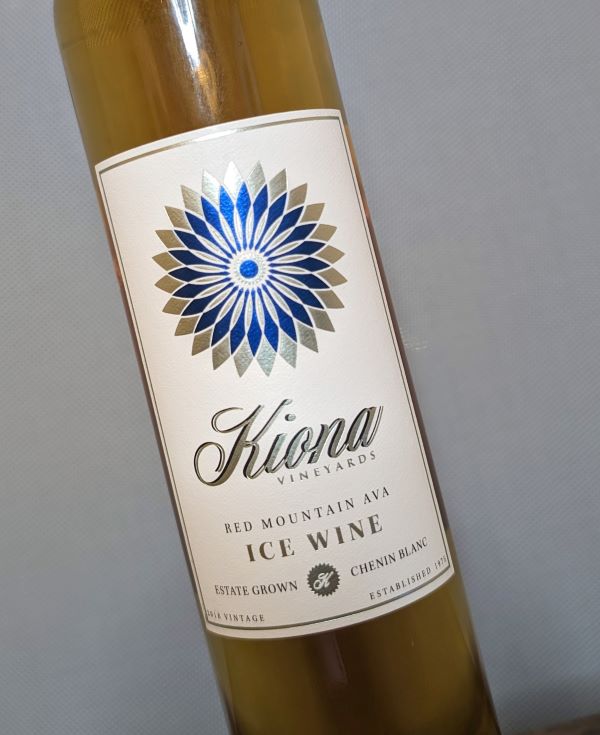
Tropical flavors of pineapple and mango, and apricot
I was delighted to learn about ice wine from the USA a couple of years back. I had only come across Canadian and German producers until then. Even better, one of them became a favorite! The Kiona Chenin Blanc Ice Wine is less sweet but it makes up for it with bright acid. That acid is coming from the Chenin Blanc grape, and the balance of sweetness with a long, lip-smacking acidity makes this a special style. The mouthfeel is lighter and less syrupy, on account of less sugar. You will fine tropical flavors of pineapple and mango, and to a lesser degree apricot and peaches.
Türk Grüner Veltliner Eiswein
| Year | Sugar Level | Grape | Region | Bottle Size | Price USD | Alcohol Level |
|---|---|---|---|---|---|---|
| 2018 | 212 g/L | Grüner Veltliner | Niederösterreich, Austria | 375ml | $44 | 8.0% |
This is a very special ice wine because it's made from Grüner Veltliner. Grüner Veltliner has a well-known character in dry white wines from Austria, and you might wonder if those markers pop up in an ice wine. Happily, they are there if you look for them! It's rewarding to find something distinctive in an ice wine, so I highly recommend comparing this side-by-side with a Vidal-based ice wine if you can. On the nose and palate there is just a hint of white pepper, a waxiness on the nose, and yellow flowers. Sweetness dominates the mid palate. This is also the highest acid ice wine I remember--one for the acid heads!
Serve ice cold!
Anselmann Silvaner Eiswein
| Year | Sugar Level | Grape | Region | Bottle Size | Price USD | Alcohol Level |
|---|---|---|---|---|---|---|
| 2016 | 212 g/L | Silvaner | Pfalz, Germany | 375ml | $44 | 7.5% |
This ice wine is also special because it's made from an uncommon ice wine varietal: Silvaner. It begs to be tasted and compared to other ice wines! The most notably different thing about this wine is that it is sweet and sour. There's white grapefruit and sour lemon on the nose, blended with tropical fruits like mango. It delivers tart acid, a tingling on the tongue at the start, followed by a long finish. At the same time it's one of the more creamy and oily mouthfeels compared to other ice wines. There is also a kind of metallic taste. A memorable favorite because it presents something different.
Peller Estates Cabernet Franc Ice Wine
| Year | Sugar Level | Grape | Region | Bottle Size | Price USD | Alcohol Level |
|---|---|---|---|---|---|---|
| 2018 | 179 g/L | Cabernet France | Niagara Peninsula VQA, Canada | 200ml | $37 | 12.0% |
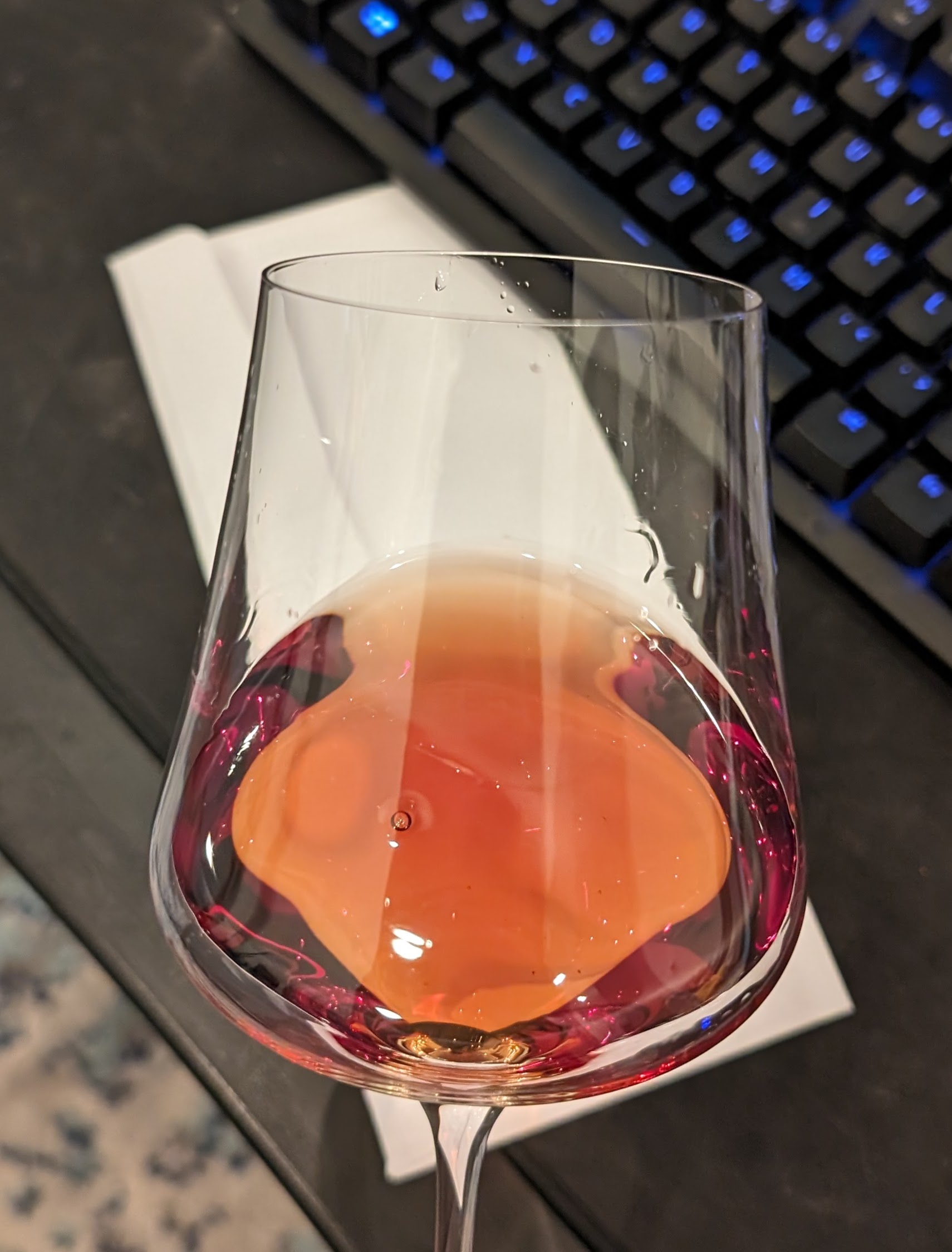
Red-amber color of Peller Estates Cabernet Franc Ice Wine
Some unique notes on another Cabernet Franc based ice wine from Canada: shortbread biscuit, black tea leaves, orange marmalade, and raspberry and strawberry flavors. There is less honey on this, and the nose is less aromatic than the Inniskillin offering. The alcohol is also a bit more prominent, and felt in the throat. Such things fluctuate by vintage, so do try different vintages if you have the opportunity!
This wine has a most gorgeous red-amber, red-gold color to feast your eyes on.
Note: There are 200ml and 375ml formats. The 200ml format comes standalone, and also in a 3-variety pack offered by Peller Estates.
Peller Estates Oak Aged Vidal Ice Wine
| Year | Sugar Level | Grape | Region | Bottle Size | Price USD | Alcohol Level |
|---|---|---|---|---|---|---|
| 2018 | 200 g/L | Vidal | Niagara Peninsula VQA, Canada | 200ml | $37 | 11.0% |
A deep deep amber color offering highly intense aromas of raisins, apricot, honey, mango, soft caramel, and perhaps the tiniest hint of vanilla. There is a perception of very low tannin leading up to the mid palate. I talk Peller Estates unoaked style in the next section. Honestly, there isn't that much of a difference between the oaked and unoaked styles. Sweetness and fruity aromas dominate both wines. The mouthfeel is ever so slightly heavier in the oaked style (accounted for by increased sugar and perhaps the aging treatment). Overall, the oak treatment appears to have a marginal effect.
Peller Estates Vidal Ice Wine
| Year | Sugar Level | Grape | Region | Bottle Size | Price USD | Alcohol Level |
|---|---|---|---|---|---|---|
| 2018 | 200 g/L | Vidal | Niagara Peninsula VQA, Canada | 200ml | $37 | 11.0% |
This is a great ice wine to understand typicity, overall a great pick, and my favorite out of the three Peller Estates ice wines I tried. A beautiful gold amber color with high intensity aromas. It has huge yellow apricot notes, mango, peaches, honey, and a floral note underneath. It is sweet and syrupy, but less thick than the Jackson-Triggs Vidal bottle. The finish is comparatively shorter, and there is a little bit of a metallic aftertaste on the finish, almost as if coming from skin contact. Medium acidity supports the sweetness well.
A.J. Adam Dhroner Hofberg Riesling Eiswein
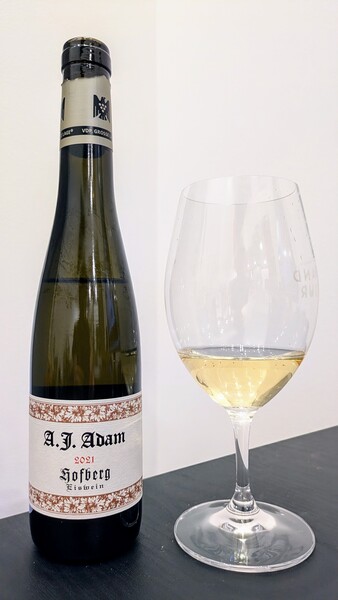
Tartness and metallic qualities that come through on the finish
| Year | Sugar Level | Grape | Region | Bottle Size | Price USD | Alcohol Level |
|---|---|---|---|---|---|---|
| 2021 | 180 g/L | Riesling | Mosel, Germany | 375ml | $86 | 5.5% |
A high quality (and therefore pricier) German Eiswein that intrigues with herbaceous notes alongside classic ice wine intensity. You'll find lemon twist, subtle candy notes, and delicate touches of saffron and apricots. It has a unique combination of tartness and metallic qualities that come through on the finish. Something lovely: aromas uniquely reminiscent of German Spätlese styles, but more concentrated. Note the low alcohol in this style, just 5.5%!
Lightly syrupy palate with great acidity. The sour profile is remarkable—Canadian ice wines don't reach this level of tartness. It reminds of the Silvaner ice wine in this post with its lemony character, and a lengthy acid-driven finish. This is a wine has infinite aging potential and the sourness will likely mellow beautifully with time.
Serve ice cold!
P.J. Valckenberg Madonna Eiswein
| Year | Sugar Level | Grape | Region | Bottle Size | Price USD | Alcohol Level |
|---|---|---|---|---|---|---|
| 2004 | 165 g/L | Riesling | Rheinhessen, Germany | 375ml | $37 | 8.0% |
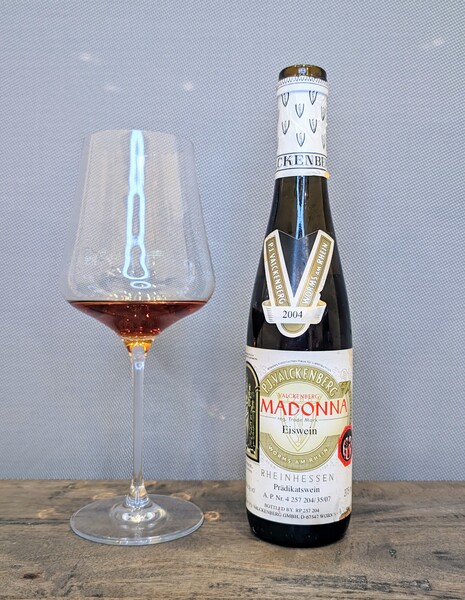
Tertiary notes of honey, apple brandy, subtle dark apricot
An aged Eiswein as an example of how German styles develop over time! It tastes of dark apple brandy and brown sugar before revealing a soft medium-plus-plus acid finish without overt tartness. What sets this wine apart is its restraint with (perceived) sweetness—it's notably less sweet than many ice wines. If you're familiar with German sweet wines, you may know that the perception of sugar dampens as age wears it down.
Light brown with a distinctive garnet tinge. Surprisingly, the texture is thinner than what you might expect from ice wine—even thinner than some Beerenauslese wines. Less intense, the medium-plus nose offers secondary and tertiary notes of honey, apple brandy, subtle dark apricot, and an intriguing musky cedar wood character that might be attributed to its age.
Overall surprisingly light and a wine that remains clean and focused with age.
Walter J Oster Spätburgunder Rosé Eiswein
| Year | Sugar Level | Grape | Region | Bottle Size | Price USD | Alcohol Level |
|---|---|---|---|---|---|---|
| 2018 | 165 g/L | Pinot Noir | Rheinhessen, Germany | 375ml | $26 | 10.0% |

Turkish delight, orange marmalade, and a medley of cherries
One of the most unique ice wines I've tried: A Pinot Noir "rosé" style. The light orange-amber colored wine shows Turkish delight, orange marmalade, and a medley of white and light red cherries. There's an elusive earthy quality and subtle saffron note that adds complexity.
This Germany style again restrains its sweetness compared to Canadian ice wines. It drinks closer to a German Spätlese in weight. The palate shows good medium acidity and an impressively long sweet finish. The lighter mouthfeel makes it particularly appealing if you find traditional ice wines too intense. With time in the glass, additional notes of brandy, leather, and candied apple emerge. Exceptional value for exploring a different expression of ice wine at this price point.
Fantastic value for the experience and quantity per dollar, though you might have trouble finding this outside Germany or the EU.
Vinařství Novosedlý Vinofol Pálava Ice Wine
| Year | Sugar Level | Grape | Region | Bottle Size | Price USD | Alcohol Level |
|---|---|---|---|---|---|---|
| 2022 | 130 g/L | Pálava | Moravia, Czechia | 200ml | $49 | 10.0% |
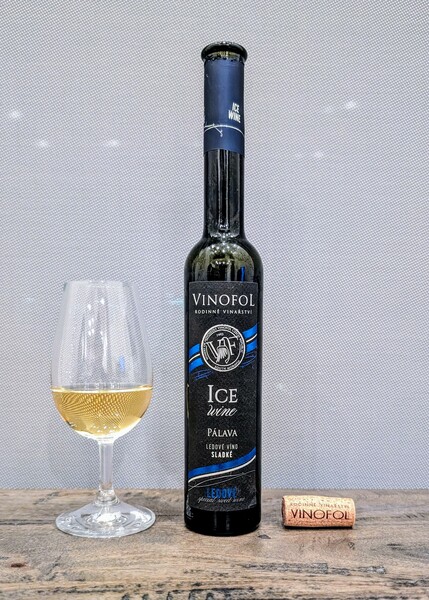
Pumpkin-vegetal, white peach, yellow plum, and candied apricot
A completely alien expression of ice wine for its unique location and grape! The Pálava grape is a cross breed of Gewürztraminer and Müller Thurgau. This Czech ice wine is light, distinctly golden, and presents a unique combination of vegetal pumpkin notes alongside tropical papaya, white peach, yellow plum, and candied apricot.
The palate is notably different from many ice wines. It's less viscous but still juicy and delivers sweetness with elegance. At 130 g/L the sugar level is noticeably lower. A long finish with a distinctive vegetal component makes this a memorable and unique addition to any ice wine collection.
Inniskillin Vidal Ice Wine
| Year | Sugar Level | Grape | Region | Bottle Size | Price USD | Alcohol Level |
|---|---|---|---|---|---|---|
| 2017 | 250 g/L | Vidal | Niagara Peninsula VQA, Canada | 375ml | $65 | 9.5% |
A classic Canadian expression and fairly widely distributed around the world. Deep amber in color, Inniskillin consistently produces high-intensity aromas with medium-plus complexity. The nose and palate showcase overripe peach, pronounced apricot, honey, and lemony citrus notes. The substantial acid backbone supports an impressive 250 g/L (!) of residual sugar. It is syrupy and built for a sweet tooth.
Whitewater Hill Vineyards Ice Wine
| Year | Sugar Level | Grape | Region | Bottle Size | Price USD | Alcohol Level |
|---|---|---|---|---|---|---|
| 2016 | 143 g/L | Riesling | Grand Junction, CO, USA | 375ml | $65 | 13.5% |

Intense white raisins, pineapple, and apricot jam
Colorado isn't a well-known region for producing ice wine by any means! It offers intense aromas of white raisins, vegetal notes, and pineapple. The nose is more tart than what you typically find in Inniskillin or Red Mountain offerings.
A second tasting one year later confirms tropical fruits with pineapple and mango taking center stage with hints of apricot jam. Acid is bright, but not intense.
The higher alcohol content (13.5%) is unusual for ice wine and suggests very ripe fruit at harvest with less acid structure. The lighter, less syrupy mouthfeel distinguishes from more traditional styles. An excellent introduction to ice wine for newcomers to the category.
Controversial Ice Wines and Almost-Ice Wines
There are some wines that are closely related to ice wines, but are considered controversial or don't satisfy the technical conditions to be labeled Ice Wine, Icewine, or Eiswein.
l'Orpailleur Ice Wine
| Year | Sugar Level | Grape | Region | Bottle Size | Price USD | Alcohol Level |
|---|---|---|---|---|---|---|
| NV | 215 g/L | Vidal | Quebec, Canada | 200ml | $29 | 9.5% |
A winery in Quebec that specializes in turning frozen grapes into dessert-style ice wine. There is some controversy around the exact method: grapes are harvested frozen and then placed in hammocks to mature through cycles of freezing and thawing.
You can find more details on the controversy in this article.
Wagner Riesling Ice
| Year | Sugar Level | Grape | Region | Bottle Size | Price USD | Alcohol Level |
|---|---|---|---|---|---|---|
| 2017 | 170 g/L | Riesling | Finger Lakes, NY, USA | 375ml | $35 | 12.9% |
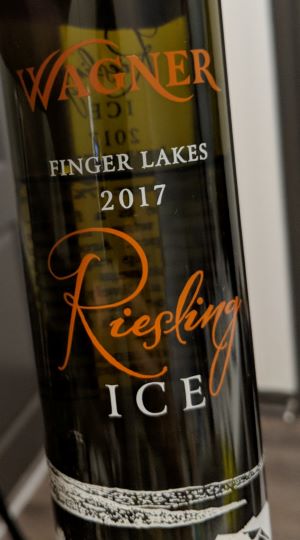
A Wine named Wagner Riesling Ice
You might see something like "Wagner Riesling Ice Wine" listed online. It turns out the name of this wine is Wagner Riesling Ice and by virtue of it being a wine, retail outlets simply append Wine. Tricky! According to online sources, the process for making this wine involves frozen grapes, but the grapes are not frozen naturally on the vine.
Perceval Pascal Vin des Glace sur le Toit de l'Europe Refuge des Cosmiques
| Year | Sugar Level | Grape | Region | Bottle Size | Price USD | Alcohol Level |
|---|---|---|---|---|---|---|
| NV | 170 g/L | Jacquère | Savoie, France | 375ml | $60 | 12.9% |
A wine made by freezing grape juice at the top of the French Alps, in natural subzero temperatures. Interestingly, it's the juice that gets frozen here and later processed. The juice is transported by helicopter. This is likely the only example using the Jacquère grape for this style wine, and incredibly unique.
Not technically ice wine, and the bottle doesn't advertise itself as "Ice Wine". The product page and French translation suggests a close connection to ice wine.
Buying tips
One thing to watch out for when buying ice wine is bottle sizes! A bottle may seem relatively cheap or expensive, and you should check the bottle size closely. The most common size I've seen is 375ml (half bottle) and 187ml (quarter bottle). A 200ml bottle is not uncommon! Less often you'll see 500ml and 750ml formats.
Pay attention to the Residual Sugar (rs) of the wine, usually expressed in grams per liter (g/L). This number tells you just how sweet the ice wine is. Like I said, thinking about this number as a percentage sugar is useful to compare wine sweetness. There is actually quite a spread, some ice wines can be twice as sweet as others.
You can keep an eye on alcohol percentage, but residual sugar is really the most significant factor. Higher alcohol content can make the wine smell more potent, and could be a good thing. I've seen alcohol range from 8% to 12%.
Full list of ice wine details in this post
Ice Wine Table
| Year | Name | Sugar Level | Grape | Region | Bottle Size | Price USD | Alcohol Level |
|---|---|---|---|---|---|---|---|
| 2019 | Jackson-Triggs Vidal Icewine Reserve | 215 g/L | Vidal | Niagara Peninsula VQA, Canada | 187ml | $25 | 9.3% |
| 2019 | Inniskillin Cabernet Franc Icewine | 265 g/L | Cabernet Franc | Niagara Peninsula VQA, Canada | 375ml | $115 | 9.5% |
| 2018 | Kiona Vineyards Chenin Blanc Ice Wine | 175 g/L | Chenin Blanc | Red Mountain AVA, WA, USA | 375ml | $44 | 9.0% |
| 2018 | Türk Grüner Veltliner Eiswein | 212 g/L | Grüner Veltliner | Niederösterreich, Austria | 375ml | $44 | 8.0% |
| 2016 | Anselmann Silvaner Eiswein | 212 g/L | Silvaner | Pfalz, Germany | 375ml | $44 | 7.5% |
| 2018 | Peller Estates Cabernet Franc Ice Wine | 179 g/L | Cabernet Franc | Niagara Peninsula VQA, Canada | 200ml | $37 | 12.0% |
| 2018 | Peller Estates Oak Aged Vidal Ice Wine | 200 g/L | Vidal | Niagara Peninsula VQA, Canada | 200ml | $37 | 11.0% |
| 2018 | Peller Estates Vidal Ice Wine | 200 g/L | Vidal | Niagara Peninsula VQA, Canada | 200ml | $37 | 11.0% |
| 2021 | A.J. Adam Dhroner Hofberg Eiswein | 180 g/L | Riesling | Mosel, Germany | 375ml | $86 | 5.5% |
| 2004 | P.J. Valckenberg Madonna Eiswein | 165 g/L | Riesling | Rheinhessen, Germany | 375ml | $37 | 8.0% |
| 2018 | Walter J Oster Spätburgunder Rosé Eiswein | 165 g/L | Pinot Noir | Rheinhessen, Germany | 375ml | $26 | 10.0% |
| 2022 | Vinařství Novosedlý Vinofol Pálava Ice Wine | 130 g/L | Pálava | Moravia, Czechia | 200ml | $49 | 10.0% |
| 2017 | Inniskillin Vidal Ice Wine | 250 g/L | Vidal | Niagara Peninsula VQA, Canada | 375ml | $65 | 9.5% |
| 2016 | Whitewater Hill Vineyards Ice Wine | 143 g/L | Riesling | Grand Junction, CO, USA | 375ml | $65 | 13.5% |
| NV | L'Orpailleur Ice Wine | 215 g/L | Vidal | Quebec, Canada | 200ml | $29 | 9.5% |
| 2017 | Wagner Riesling Ice | 170 g/L | Riesling | Finger Lakes, NY, USA | 375ml | $35 | 12.9% |
| NV | Perceval Pascal Vin des Glace | 170 g/L | Jacquère | Savoie, France | 375ml | $60 | 12.9% |
I hope this helped you enjoy happy touring! I want to hear from you and your experience. I'm human and you can talk to me on instagram / twitter / e-mail.

